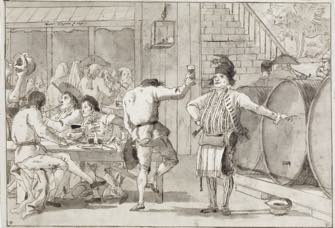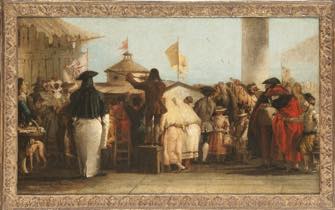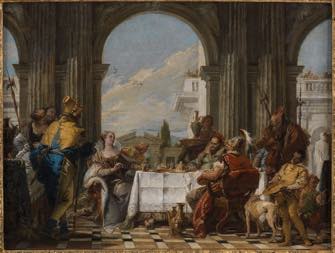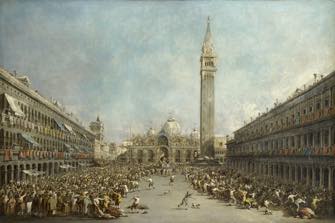
The glorious millennium of the Venetian Republic came to a definitive end in 1797 with Napoleon’s invasion and the forced abdication of the doge. Even in its final days during the 18th century, however, the city, flush after several decades of peace and prosperity, never stopped throwing lavish public pageants complete with elaborate pop-up scenery in Saint Mark’s Square and regattas on the Grand Canal, while the dramatic arts flourished in new theatres and on the streets, aristocrats partied behind the closed doors of their palazzi, and commoners filled the streets and taverns.
Venetian painters recorded all of these festivities – which turned the beautiful city itself into a theater – in almost photographic detail and jewel-like colors.

The first image that catches the eye is a black-and-white drawing by Giandomenico Tiepolo, “La Malvasia” (a type of tavern named after a wine that had once helped fill the Venetian coffers) in which the smug-looking owner points the way to the door to a rowdy customer, dancing with his back turned to the viewer, while other customers drink and smoke behind him.

Many of the more intimate moments were documented by Giandomenico Tiepolo and his brother Lorenzo. The former, for example, painted “Il Novo Mondo” (c. 1765), a version of the famous fresco now in the Ca’Rezzonica in Venice, in which we see a varied group of spectators, some in Carnival costumes, from the back as they strain to see a cosmorama, an entertainment involving panoramas of other parts of the world, known as a Novo Mondo.

A work by their father, Giambattista Tiepolo, showing Cleopatra’s banquet, is thrown in for good measure, though it depicts a historical scene: Meanwhile, more extravagant festivities were taking place outdoors. Carnival was, of course, the best-known celebration, but any excuse was a good one. A series of fascinatingly detailed engravings shows everything from parades of fantastical carriages to bull running in the Piazza San Marco.

Francesco Guardi recorded the election of Doge Giovanni Mocenigo in 1763 in Saint Mark’s Cathedral. The scene looks more like a brawl as the jubilant crowd is pushed back by men with long sticks. In another painting by Guardi we see the doge being carried by gondoliers outside the cathedral as the men with sticks beat back the crowds anxious to catch the gold and silver pieces being thrown by the doge.
A number of works by Luca Carlevarijs (1663-1730), the first to paint the cityscapes of Venice that became so familiar with Canaletto and Guardi, are on show here. One could spend hours being amused and amazed by the incredible detail in the crowd scenes, often far more interesting that what’s going on in the grand pageant in the background, as charlatans scam the innocent, vendors hawk their wares, masked Venetians gossip with each other, and dogs scratch their fleas.
When Napoleon himself rolled into town in 1807, his arrival was duly fêted. Two paintings here commemorate the event, both by Giuseppe Borsato, one showing the emperor’s elaborate boat passing through a triumphal arch built for the occasion (pictured at the top of this page). In the other, the emperor is barely visible, standing on the balcony of a palazzo presiding over a regatta being held in his honor.
This little gem of a show is almost as entertaining as the festivities in Venice itself and is the next best thing to going to the Serenissima.
Favorite